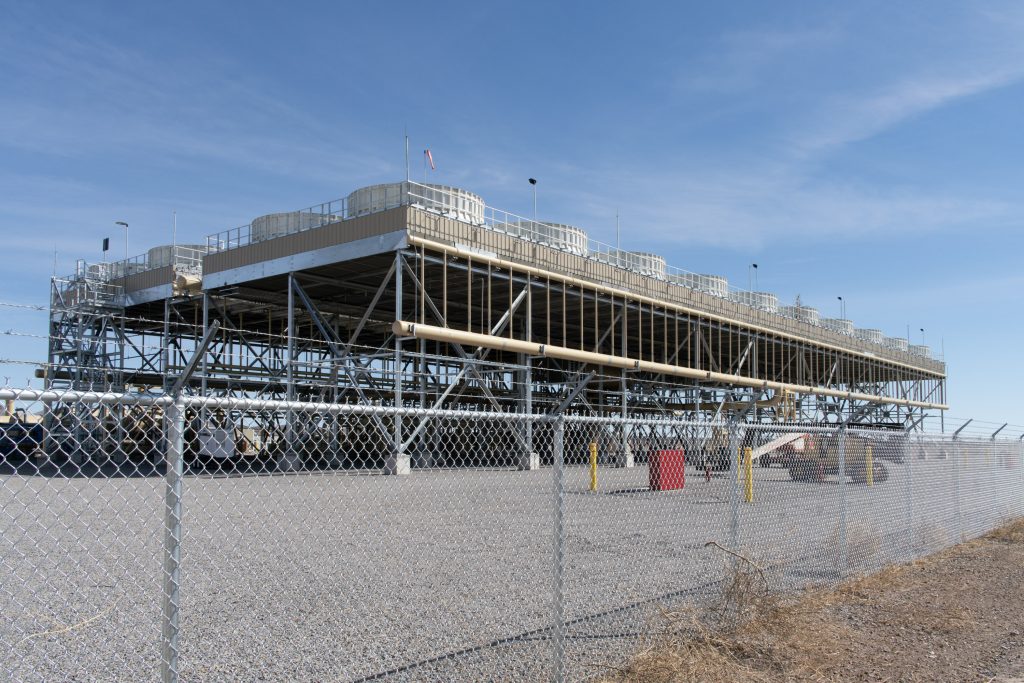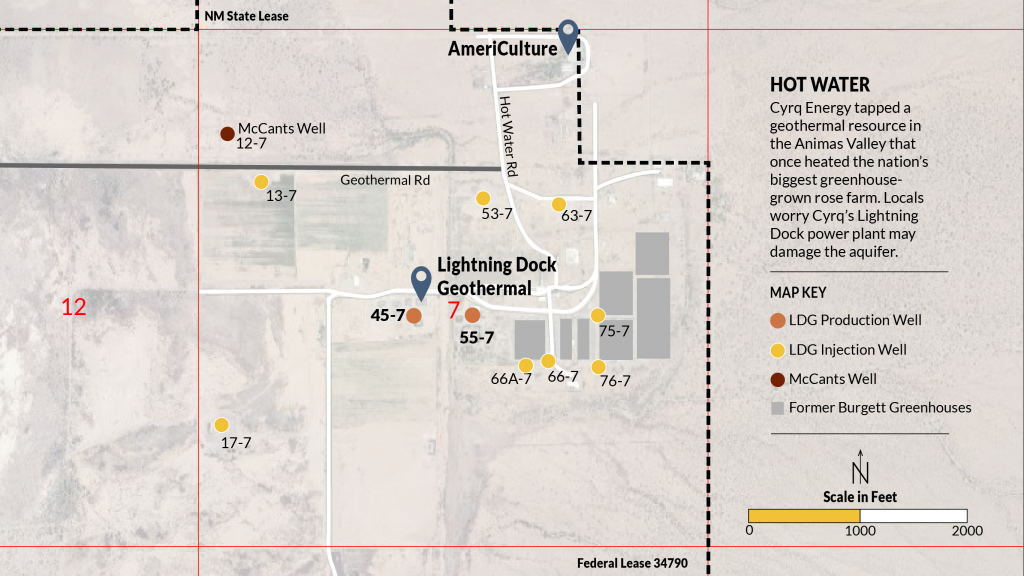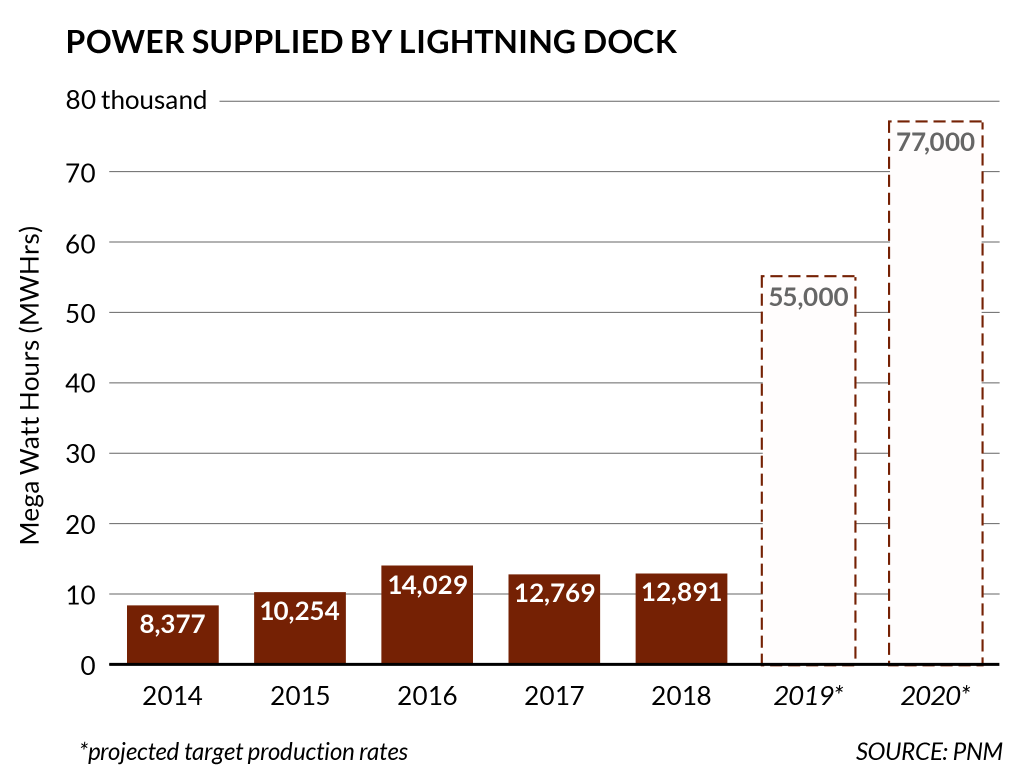ANIMAS VALLEY — Riding his horse through cattle pasture of brush and brittle mesquite, Randy Walter spotted a steaming, 10-foot geyser spewing from a well that had been capped and padlocked for 12 years. It was March 2016, and Walter had ranched the dry terrain of New Mexico’s Bootheel for as long as he could remember.
If he knew one thing about the Animas Valley, it was this: Water doesn’t just blow out of the ground.
Two miles away, a Utah company called Cyrq Energy had erected a $43 million geothermal electricity plant in 2013. Its green pipes and rectangular pods of turbines rose like stacks of giant Legos in the desert.

The Lightning Dock power plant was supplying the state’s largest power provider, Public Service Company of New Mexico, with about four megawatts toward the state’s renewable energy goals — roughly enough to power 1,400 houses for a year.
From the outset, local residents had questioned Cyrq’s assertion that it could pump geothermal water from thousands of feet down and reinject it at similar depths without tainting the shallow, freshwater aquifer. Like many places in New Mexico, the health of the local farm and ranch economy is rooted to the water. So are the lives of the scattered people who live in the Animas Basin.
“The valley has been productive through the years and it has sustained a rural community,” said Stan Jones, chairman of the locally elected Hidalgo Soil and Water Conservation District. “That geothermal water is not water that can be used to farm or ranch with. That is why we are so adamant: That’s our livelihood they’re messing with.”
By the time Walter stumbled on the blown well, the spillage had soaked roughly an acre. The landowners — his in-laws, the McCants family — immediately demanded an investigation by the Office of the State Engineer, the agency historically responsible for managing water in New Mexico.
But the state didn’t investigate. Nor did it test the water for geothermal toxins.
Instead, with the State Engineer’s blessing, Cyrq plugged the well with cement and welded it shut — permanently.
Water at risk
The dark side of renewable energy is that every form of production carries its own environmental baggage. Without an ecological review, wind farms can put native and migratory birds at risk. Solar farms can interrupt ecosystems by fencing off and shading swaths of desert acreage. And geothermal energy, which has some advantages over wind and solar, can jeopardize freshwater resources.
In Hidalgo County, the deep geothermal water is dirty with naturally occurring contaminants — especially high levels of fluoride, a mineral that, when consumed in excess, is dangerous to bone health.

“Geothermal isn’t terribly new; we just don’t have a regulatory framework for most of this stuff,” said Ben Shelton, legislative director of Conservation Voters New Mexico, an environmental lobbying group based in Santa Fe. “If it seems lacking in New Mexico, it’s because it is lacking.”
On the positive side, geothermal plants typically take up far less acreage than solar or wind farms, leaving a smaller environmental footprint on the surface. The energy, extracted from dry heat or hot water deep underground, generates power around the clock and isn’t subject to changes in the weather.
Nationwide, electricity generated from geothermal grew about 9 percent between 2007 and 2017, according to the Energy Information Administration. Lightning Dock is New Mexico’s only utility-scale geothermal power plant.
Cyrq, formerly known as Raser Technologies, retooled its business model in 2007 to exploit the growing market for geothermal energy. But it has a checkered past, including two bankruptcies, a retreat from the New York Stock Exchange back into private hands, a falling-out with Chinese creditors and ongoing litigation with an Animas Valley tilapia farm.
Though Cyrq declined multiple interview requests and did not respond to emailed questions, Searchlight’s report is based on hundreds of pages of public testimony, official correspondence, Securities and Exchange Commission filings, and state and federal litigation.
The company’s operating premise in the Animas Valley was for a “closed loop” system: Lightning Dock would pump 250-plus-degree water from the valley’s geothermal resource, pipe it through a plant to generate electricity, then re-inject the hot water back where it came from without consuming it or contaminating the shallow aquifer.

Locals worried that the state, in its zeal to promote renewable energy, was willing to risk their water for a green energy project.
“Not all of the questions are answered,” said Carl Chavez, an environmental engineer with the Oil Conservation Division, at the plant’s grand opening in 2013. “They are proceeding at some risk if there are any water quality issues, any water drawdown issues.”
PNM gambled on the project in part because it had to: The utility was subject to a “diversity” rule that forced it to buy renewable energy from a source other than wind or solar.
“While the plant has had some production shortfalls and a bankruptcy, PNM is committed to this renewable generation,” said spokeswoman Kelly-Renae Huber. “As part of that commitment, we were able to avoid canceling their contract until they were able to improve the efficiency of the project.”
Even before the McCants’ well blew, there were signs that the hydrogeology of the valley was neither cut nor dry.
A hot spot for investment
The first person to tap the hot water of the Animas Valley on a grand scale was Dale Burgett. The maverick rose farmer poked holes around the valley in the 1970s, often without state permission, looking for the hottest spot. He found it near what is now the intersection of Geothermal and Hot Water roads, about two miles east of where the well blowout occurred. That’s where the 312-degree water of a geothermal plume swells toward the surface.
The unique hydrogeology of the Animas Valley can be imagined from above like a dartboard where that bullseye is the hottest spot. The hot water — with a chemical makeup that makes it not suitable for consumption by humans or livestock — naturally seeps into the surrounding freshwater aquifer at a rate of 300 gallons per minute. The water flows north underground and becomes progressively cooler and cleaner as it moves away from the center.
Burgett piped the geothermal water through football-field-size greenhouses to warm his rose bushes and, in doing so, became the nation’s largest rose producer. By the early 2000s, Burgett Geothermal Greenhouses was shipping 25 million roses annually — until Latin America captured his market share and his business went south. Burgett died in 2013 at age 88.
Cyrq, meanwhile, acquired $4.9 million in federal and other leases to develop geothermal resources where Burgett’s hulking, dilapidated greenhouses still loom. Hundreds of thousands of his rose bushes still stand in perfect rows, moribund in their buckets.
Across from the rose farm, near the McCants property, Damon Seawright — an entrepreneur with a doctorate in fisheries science — founded a warm-water aquaculture farm in the 1990s called AmeriCulture Inc. He and his wife Libby home-schooled two boys there while building AmeriCulture into one of the largest tilapia hatcheries in North America.
When Cyrq ran a red tracer dye through wells to test water flow in 2012, the Seawrights’ tilapia turned the color of carnations. Hundreds of thousands of fingerlings died. The incident exacerbated locals’ concerns, and protests mounted at the Office of the State Engineer.
So the state simply eliminated the path of protest. During the 2012 legislative session, southern New Mexico Democrats Sen. John Arthur Smith and Rep. Rudy Martinez co-sponsored a bill that took jurisdiction over 250-plus-degree water from the Office of the State Engineer and placed it in the hands of the Oil Conservation Division.
In other words, the hot water was no longer considered water, but energy. The agency historically tasked with managing water in New Mexico was stripped of its authority over the project.
Nor could residents seek relief from the federal government. Federal regulations place geothermal injection wells in the same category as septic tanks: They are allowed to degrade groundwater.
Hydrology 101
“We get along with everybody in the community,” said Tom Carroll, whose Albuquerque firm handles public relations for Cyrq.
The community’s reluctance to talk candidly about the company suggests otherwise.
Damon Seawright refused to be interviewed, citing ongoing litigation with Cyrq over water issues. The McCants family didn’t return phone or email messages, while state engineers familiar with the project spoke only on condition of anonymity.
One of the people unafraid to speak out is Meira Gault, a 69-year-old cattle rancher who once served in intelligence in the Israeli Army and has been a Hidalgo conservation district official for 11 years.
Gault said she views the well blow-out as the surest sign that the geothermal water simply isn’t going where Cyrq promised it would go.
“It’s the feeling that something is wrong that is bigger than the problems of this or that individual,” she said.
To understand how the well blow-out happened, locals refer back to Cyrq’s 2015 application to drill three new, shallow injection wells. Lightning Dock at the time still wasn’t meeting expectations. Its “closed loop” scheme had proved inadequate to producing the 12 to 15 megawatts, as promised.
When the state approved the new wells, it did so on the condition that they be drilled below “a silicified layer” — a hard rock barrier — to protect the shallow aquifer. Cyrq was then allowed to re-inject hot water far from the central plume, not far from the McCants well.
The state maintains that Cyrq is in compliance with regulations. But residents have for the past two years requested information seeking verification. All documents have come back heavily redacted.
The injection well is “in the same aquifer the ranchers have their windmills in and farmers have the wells in,” said Jim Witcher, a local hydrogeologist. “But we know the water is flowing north into the aquifer; it’s not flowing southeast into bedrock. That’s hydrology 101.”
The long view
As of January 2018, new state rules govern the development of geothermal projects, and Lightning Dock will be required to apply for new permits by 2023.
But until then, Cyrq enjoys substantial privilege, selling expensive power to PNM. The new state Energy Transition Act of 2019 frees PNM from renewable energy requirements if the electricity costs more than $60 a megawatt-hour. Solar and wind cost half that amount now. Meanwhile, a contract locks PNM into paying Cyrq $97 per megawatt-hour for the next 20 years, as long as the company delivers the power it promised.
This spring, Cyrq will celebrate the second grand opening of Lightning Dock in five years. The reason? According to its spokesman, the plant has finally met its longtime production target for generating 10 to 12 megawatts full-time.
That goal may not be cause for celebration for residents of the Animas Valley, however. It signifies that the plant is re-injecting the geothermal water at a much higher rate, since all the water that comes up must go back down in the ground.
With the McCants well sealed and no monitoring wells north of the nearby injection site, Lightning Dock could contaminate the aquifer without anyone knowing until it’s too late.
“I am not against green energy,” Gault said. “But I’m not sure that it is safer or cleaner. The interest of the money people is not that different on the green side or the oil side.”